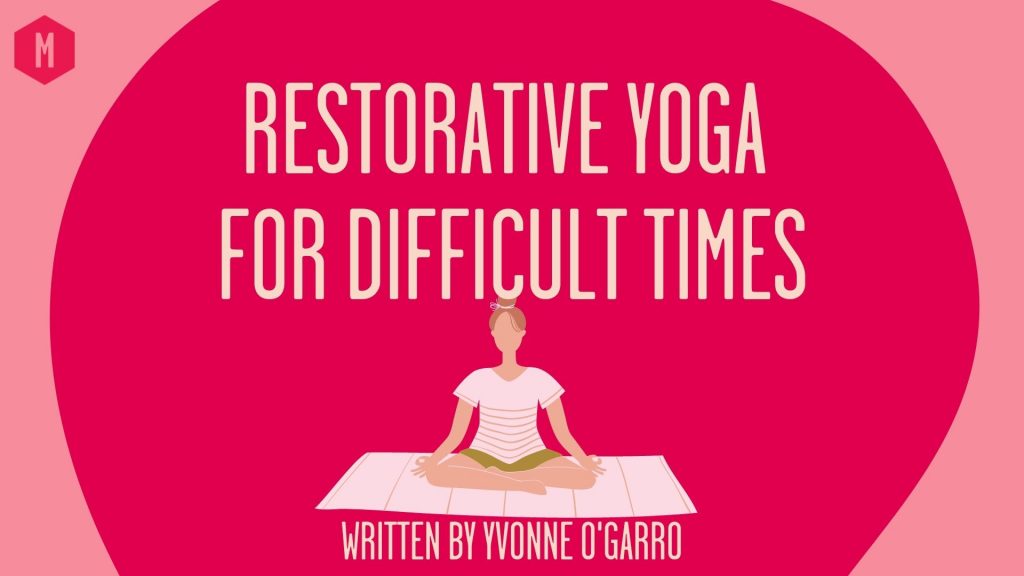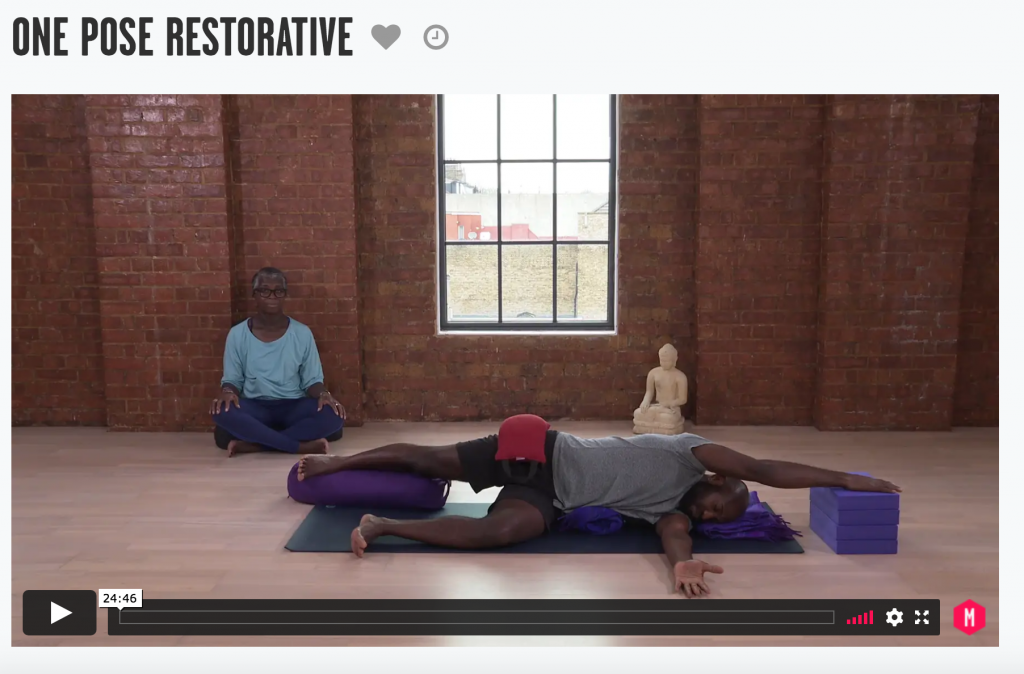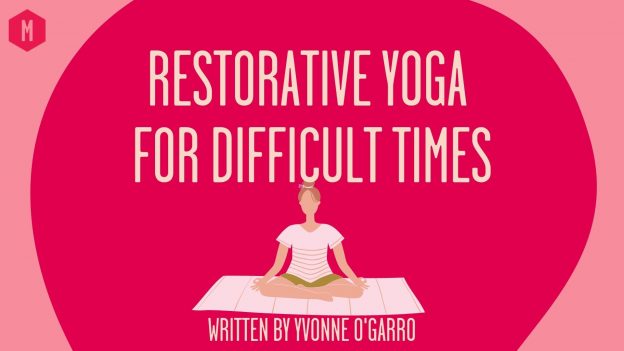
Do you find it difficult to feel rested during difficult times in your life? Restorative Yoga can help you during difficult times in your life. Yvonne O’Garro explains how this deeply nurturing practice can help you.
Restorative noun. “Something that makes you feel better or more energetic if you are feeling tired or ill” (Cambridge Dictionary Online).
Restorative yoga is the practice where it appears that “not a lot is happening” as the postures require stillness from the student. But we know that appearances can be deceiving.
Permission to Rest
We honour B.K.S Iyengar for both his creation of the props and devising the slow, still, and nurturing practice that we know today as Restorative yoga. The props allow students to access postures and in Restorative yoga the access provides the body with a release. When the body releases tension, it can more easily relax. When the body is relaxed, you feel rested which will create an increased sense of wellbeing. The props often used in Restorative yoga are (the list is not exhaustive, and you can improvise with household items):
- Bolsters (1 or 2)
- Belt or strap (1)
- Eye pillow or soft cloth or scarf (1)
- bricks or tins (2)
- blankets (2, 3 or more!)
The nature of Restorative yoga fully lends itself to helping us navigate difficult times because the set-up is most definitely cosy and nurturing plus you are giving yourself permission to rest whilst being guided into the longer held postures that facilitate a release. I found Restorative yoga in 2006 and it has been my solace when I have faced challenges in my previous HR career, being stressed when navigating care support for my late Mum and most definitely the past 7 months facing into COVID and Black Lives Matters protests.
Navigating difficult times
In Dr Gail Parker’s book, Restorative Yoga for Ethnic & Race Based Stress and Trauma, she states of the racialised world we are living in “…It is time for each one of us to take an honest look at the wounding we have inflicted on others, whether intentional or not…Now is a time for us to turn within and for healing our own pain as if our very lives depended on it because they do. I believe Restorative Yoga is a tool that can help us do that”.
Why does restorative yoga work?
Restorative yoga does not require any previous yoga experience. Regardless of your preferred yoga style if you do have a regular practice, Restorative can help you feel better. Why? Because you are allowing the body to be still, this stillness cannot be underestimated. The stillness permits the body to start to release any patterns of holding that we could be experiencing from any current or past situation be that relationships, career, financial or personal matters. The release, as mentioned earlier, contributes to an improved sense of wellbeing, this is achieved by allowing the nervous system to shift from what is known as “fight or flight” – the Sympathetic nervous system into the relaxation mode – the Parasympathetic nervous system.
It takes the body on average 15 minutes to shift from “fight or flight” to the relaxation mode which is why the postures are longer held in the Restorative practices, anything from 5 – 20 mins (class duration dependent), to enable the body to rest and release tension. Restorative yoga has a calming effect on the body, slows the heart rate, and contributes towards lower blood pressure, stress, and anxiety levels. The props provide a sense of comfort and the set up of the postures ensure students feel safe and held. You are encouraged to make any adjustments that make a posture feel even more comfortable, that may mean an additional blanket or foam block; whatever is required to achieve a sense of ease and comfort that returns us to the definition of Restorative – “something that makes you feel better”.
Connect to Breath
The breath is a key focus of our yoga practice. Restorative yoga allows us to reconnect with our breath as it helps us to remain in the stillness of the practice that may feel challenging, as your thoughts race around. If we focus on the exhale of our breath pattern, not forcing or directing, just observing, you may notice that the breath starts to slow down, and the exhale lengthens beyond the inhale. This is the perfect foundation for the parasympathetic nervous system to start to engage leading eventually to a fuller release towards relaxation mode.
Rest
This excerpt from David Whyte’s Rest is quite fitting to help bring to life how Restorative can help us to navigate difficult times:
Rest is the conversation between what we love to do
and how we love to be.
To rest is to give up on the already exhausted will
as the prime motivator of endeavour, with its endless
outward need to reward itself through established goals.
To rest is to give up on worrying and fretting and the sense
that there is something wrong with the world
unless we are there to put it right;
to rest is to fall back literally or figuratively from outer targets,
and shift…..to an inner state of natural exchange.
The template of the natural exchange is the breath,
the automatic giving and receiving
that forms the basis and measure for life itself
We are rested when we are living that exchange……
Making Time for Restorative
Judith Lasater (one of Iyengar’s students and restorative yoga doyenne) believes strongly that we should all do one Restorative posture each day for 20 minutes as it is so very good for our nervous systems.
Sometimes it is difficult to make time for your yoga practice. The props needed for Restorative may seem fussy and time consuming to arrange. My suggestion to reap the benefits of Restorative if you are “time poor” is to adapt Judith Lasater’s advice and practice 1 posture per day/every other day for 20 mins and see if you are able to increase to 30 mins and maybe 2 postures increasing where feels appropriate towards an hour.
Restorative yoga could be a type of healing. It provides an outlet to stress, anxiety and tension and lets you reconnect with your breath; you have created time and space to rest in postures that allow the body to release.
How to make the most of your Restorative Yoga
To get the best from your Restorative practice I suggest following this guidance:
Preparation
Decide which room you are going to do your Restorative session in and gather props above ready. Put a sign on the door so you will not be disturbed. If attending a live session, set up camera so the Teacher can see you laying on the whole mat.
Environment
Your nervous system reacts to lighting, temperature, and noise. Close your blinds and curtains or dim lighting and you will relax sooner. Your body temperature drops as you lay in the longer holds of Restorative so avoid draughts. I recommend listening to the Tamboura, an Indian string instrument that is very grounding and draws you into your practice.
I hope this has given you some insight to how a Restorative practice can help you navigate difficult times. Enjoy practicing and I am happy to answer any questions that you may have.
Practice restorative yoga
If you’ve been inspired, why not let Yvonne guide you through a restorative yoga practice? Pick from Yvonne’s classes on MFML or get started straight away with this class:

About Yvonne O’Garro:

Yvonne attended her first yoga class out of curiosity and child’s pose made her fall in love with yoga. Yvonne noticed her yoga practice made an impact on her daily life: she felt less stressed and more patient and grounded. She began to take more interest in philosophy and eventually trained to teach yoga. She now specialises in teaching restorative yoga.





Leave a Reply